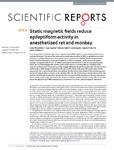Static magnetic fields reduce epileptiform activity in anesthetized rat and monkey

Ver/
Use este enlace para citar
http://hdl.handle.net/2183/21286
A non ser que se indique outra cousa, a licenza do ítem descríbese como Creative Commons Attribution 4.0 International Licence (CC-BY 4.0)
Coleccións
- Investigación (FCS) [1293]
Metadatos
Mostrar o rexistro completo do ítemTítulo
Static magnetic fields reduce epileptiform activity in anesthetized rat and monkeyAutor(es)
Data
2018-10-30Cita bibliográfica
Rivadulla C, Aguilar J, Coletti M, Aguila J, Prieto S, Cudeiro J. Static magnetic fields reduce epileptiform activity in anesthetized rat and monkey. Sci Rep. 2018;8:15985
Resumo
[Abstract] Increasing evidence indicates that static magnetic fields (SMF) reduce cortical activity in both human and animal models. The aim of this work was to investigate the effect of SMF on epileptiform cortical activity, a condition related to an abnormal increase in neuronal excitability. The first experimental block included a Pilocarpine rat model of epilepsy, in which a magnetic neodymium nickel-plated cylinder, a magnetic field of 0.5 T, or “sham” were placed over the skull. In the second experimental block, we recorded epileptic-like activity in the visual cortex of a monkey (Macaca mulatta) under control conditions and in the presence of the magnet. Between 15 and 30 minutes after the second dose of Pilocarpine, EEG changes compatible with seizure like events induced by Pilocarpine were clearly observed in the control animals (sham stimulation). Similar effects were visible in the animals exposed to the real magnet after 1–2 hours. In the monkey, SMF over the cortical focus clearly reduced abnormal activity: the intensity threshold for visual induction increased and the severity and duration decreased. These results reinforce the view that static magnets modulate cortical activity and open the door to the future therapeutic use of SMF in epilepsy as a complement to current pharmacological treatments.
Versión do editor
Dereitos
Creative Commons Attribution 4.0 International Licence (CC-BY 4.0)
ISSN
2045-2322






